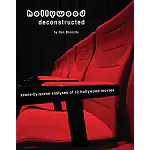Instead of writing a bunch of short scenes with little or no dialogue as separate steps in your story, why not group them together in a sequence and count it as one scene? This way you can still give the audience the information they need but you compress the method in which you reveal it – adding pace to your story.
Okay, you say, we’ve seen this a zillion times in movies.. and it’s called a “montage”. A sequence of shots, typically put to music to show the condensed passage of time. It’s a screenwriting device that sometimes helps a script and sometimes, as with all over-used devices, hinders it. Just like anything you do when creating a screenplay you have to make sure that every story, character or stylistic element is justified. That means, asking yourself the question “Does it make sense to have this here?”.
The typical use of a montage sequence can be seen in movies like The Karate Kid or Flashdance – whereby the central character has to learn how to do karate or how to do a complicated dance routine. If the scenes were played in real time the audience would be sitting in the movie theater for weeks and would probably be a little bored. Similary, if you just jump to the scene where the Karate Kid does the “crane”, the climax wouldn’t have any impact and we’d be asking ourselves how in hell did this scrawny little kid suddenly know how to do such an amazing karate kick! It just wouldn’t be believable.
So it is clear that in this example that a montage sequence is necessary. But the problem is, we’ve seen them done so many times it forms a part of our instinctive cinematic language. This can be a good thing, because we know what’s going on and don’t have to be educated – we just accept it. But conversely, it doesn’t really break any boundaries for the cinematic art form and can often be the choice of a lazy writer.
If you decide that a montage sequence is absolutely the only way you can convey your character’s emotional or physical development in a short passage of time then go ahead, use it, but try to be innovative. Maybe don’t use music. Or perhaps use split-screen so the events unfold in condensed time in parallel to real-time events. Maybe you could even disguise the sequence through other techniques such as CGI, voice-over, flicking through pages of a book.. who knows, that’s up to you.
The point is, whatever screenwriting device you use from your creative writing toolbox, don’t be lazy. Always force yourself to find a creative solution to your storytelling and never settle for something because it’s the easy option.




